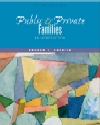EXERCISE 1 To investigate the market in Russian women who are willing to marry an American man, visit one of the many web sites maintained by matchmaking firms like the one Randy Heisey used. Scanna International (www.scanna.com) has on-line booklets of eligible Russian women. For information on the modern mail-order bride industry, go to www.bridesbymail.com, which includes an on-line resource library. What kinds of marriages are these sites marketing to American men? EXERCISE 2 In recent years, a loosely knit "marriage movement" has arisen to promote marriage. Visit the web site of the Coalition for Marriage, Family, and Couples Education, www.smartmarriages.com, to obtain information. What is the case this group is making for marriage? EXERCISE 3 The On-Line Marriage Market Find a site for an on-line dating service. (See http://www.kiss.com as an example) What types of qualities are being advertised? What is defined as success? What sociologist is being used as a "relationships expert" on this site? How would a knowledge of sociology contribute to one's success on the market? EXERCISE 4 Polyamory The courts are beginning to challenge the existence of polygamist marriages in this country. See how they are justified by the participants by visiting the site of The Polyamory Society (http://www.polyamorysociety.org/), a group whose purpose is to support this community. Click on Introduction to Polyamory on the left. Browse the site and ponder the following: 1. How does polyamory compare to monogamy? What is polyfidelity? 2. What appears to be the underlying principle of polyamory? 3. What kinds of people are most likely to be involved? 4. How do polyamorists deal with the legal issues? 5. What do you think is the future of this movement? EXERCISE 5 Unmarried Couple Households The 2000 census collected data on unmarried couple households. View the overview census table DP-1 of the US population at http://www.census.gov/prod/cen2000/dp1/2kh00.pdf. (You will need an Abode reader to view.) How many couples are classified as "unmarried partners"? What percent of all households does this represent? From your reading in the text, how has this changed over time? | 


 2002 McGraw-Hill Higher Education
2002 McGraw-Hill Higher Education